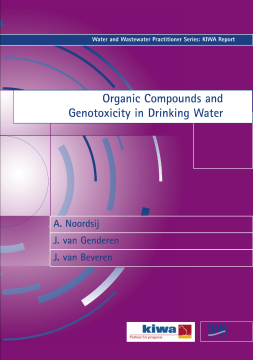
BOOK
Organic Compounds and Genotoxicity in Drinking Water
A. Noorsij | J. van Genderen | J. van Beveren
(2004)
Additional Information
Book Details
Abstract
Until recently only lipophilic compounds were analysed in any research on the occurrence of mutanogenic and carcinogenic compounds in water. They were isolated using XAD-resins. They contain approximately half of the total organic material present in water. A clear mutanogenic effect was demonstrated for these compounds using Amestest. The hydrophilic fraction of the organic material was difficult to investigate because of problems with isolation and analysis caused by its high solubility. The high solubility means in practice that the hydrophilic compounds are mobile in conventional treatment systems and in soil and can easily penetrate into drinking water. A method was developed to isolate hydrophilic compounds using a combination of ion exchange and a clean-up with a XAD-resin. The isolated compounds were examined with the Amestest for the presence of mutanogenic compounds. For some tested water types a mutanogenic effect was found in the lipophilic material. Due to oxidation with ozone, mutanogenic compounds can be formed from (non-mutanogenic) industrial pollutions. No mutanogenic activity was found in the hydrophilic organic material of all examined water types, even after ozone oxidation or chlorination. It was hypothesized that hydrophilic compounds can not reach the DNA of the cell, thus they do not play any (geno) toxicological role.
Table of Contents
| Section Title | Page | Action | Price |
|---|---|---|---|
| Contents | 5 | ||
| Summary | 6 | ||
| 1.0 Introduction | 8 | ||
| 1.1 Organic compounds in water | 8 | ||
| 1.2 Classification of organic compounds | 8 | ||
| 1.2.1. Hydrophobic compounds | 9 | ||
| 1.2.2. Hydrophilic compounds | 9 | ||
| 1.3 Mutagenicity and hydrophility | 9 | ||
| 2.0 Associated experiments | 11 | ||
| 2.1. Choice of water types for the research | 11 | ||
| 2.2 Experimental set-up | 12 | ||
| 3.0 Results and discussion | 6 | ||
| 3.1 Description of the isolated material | 6 | ||
| 3.2 Quantification of adsorbed organic material | 7 | ||
| 3.3 RESULTS OF THE AMES TEST | 7 | ||
| 3.4 The organic material and the mutagenicity in a scheme | 9 | ||
| 3.5 Availability hypothesis | 10 | ||
| 3.6 The influence of oxidation on the mutagenic effect | 11 | ||
| 4.0 Conclusions | 12 | ||
| 4.1 Origin and amount of the hydrophilic material | 12 | ||
| 4.2 Mutagenicity | 12 | ||
| 4.3 The meaning of the results to evaluate the drinking water quality and treatment | 13 | ||
| Literature | 14 | ||
| Appendix 1: The Ames test and the transport of compounds through biological membranes | 8 | ||
| Appendix 2: Sampling locations and examined water types | 11 | ||
| Appendix 3: Quantification of adsorbed organic material | 12 | ||
| Appendix 4: Chromatografic characterisation of isolated material | 14 | ||
| Appendix 5: Results Ames test | 17 |
